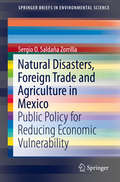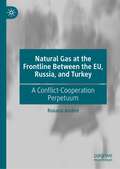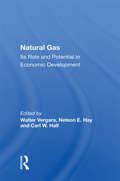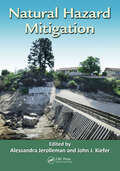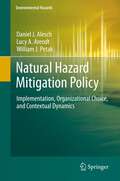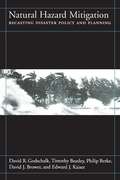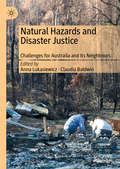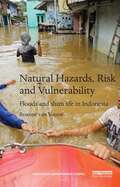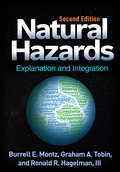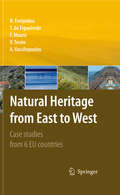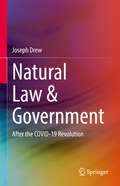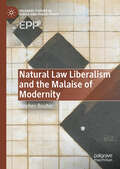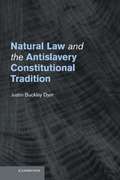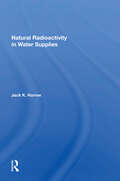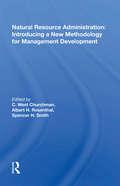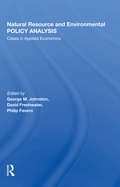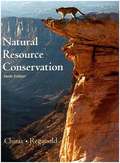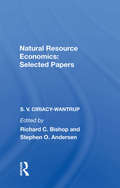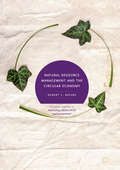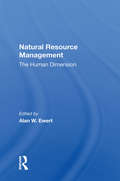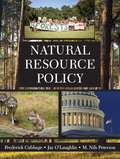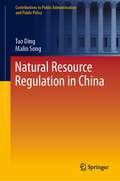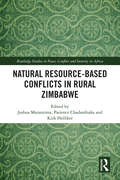- Table View
- List View
Natural Disasters, Foreign Trade and Agriculture in Mexico
by Sergio O. Saldaña ZorrillaThis work responds to the increasing global need of measuring and analyzing impacts, vulnerabilities and coping capacity of countries, regions and communities regarding climate change, extreme weather conditions, natural disasters and institutional constraints. The case of Mexico, analyzed in this work, provides lessons for further developing countries to assess natural disasters vulnerability, for making informed adaptation decisions and to optimize resources for reducing country and community vulnerability. This book's analyses contribute to the current debate of the long-term economic impact of natural disasters (hurricanes, earthquakes, etc. ), as well as offer an integral methodology combining natural and social sciences for studies of country and community level vulnerability to climate change. The lessons derived from this analysis provide useful elements for the design and improvement of governmental policies concerning social and economic development as well. In addition, the desegregation of this analysis has the advantage of facilitating the design and evaluation of governmental projects at municipal, sub-national and national level, as well as provides conceptual-empirical elements for international cooperation in matters of disaster risk reduction, climate change adaptation, rural development and poverty reduction.
Natural Gas at the Frontline Between the EU, Russia, and Turkey: A Conflict-Cooperation Perpetuum
by Roxana AndreiThis book analyses the rapidly unfolding events that have impacted on the European energy dynamics, in the light of the way in Ukraine and the energy crisis that have reconfigured, since 2022, the European and the global geopolitical scene, dislocating not only crucial natural resources but also the pace of the energy transition and the continent’s existential security, its basic trust and sense of continuity. It introduces an innovative interpretation of the conflict and cooperation dynamics in Europe, by challenging the reader to look beyond the material aspects of energy security, related to supply and demand, consumption, production and prices dynamics, which I nonetheless explain in detail. Thus, it invites the audience to explore the deeper layer of motivations that underpin the actors’ decision to engage in conflict and cooperation, by exploring their cognitive and psychological considerations, in addition to the material ones. For this purpose, it presents a new conceptual tool, the conflict-cooperation perpetuum, in order to explain why the same players, in this case the EU, Russia and Turkey, may choose to simultaneously perceive each other as security threats and trade partners, engaging in both conflict and cooperation simultaneously with the same ‘Other’. In addition, it proposes to apply the framework of ontological security, in order to understand the responses of the EU, Russia and Turkey to the major existential crises that have affected them in past years, culminating with the war in Ukraine and the energy crisis of 2022.
Natural Gas: Its Role And Potential In Economic Development
by Walter Vergara Nelson E. Hay Carl W. HallThis book is concerned with the multifaceted character of natural gas and the potential for its utilization as a powerful tool for future development. It deals with the specifics of gas uses in a number of sectors chosen for their relevance in the development of industrial economies.
Natural Hazard Mitigation
by Alessandra Jerolleman John J. KieferOne of the four core phases of emergency management, hazard mitigation is essential for reducing disaster effects on human populations and making communities more resilient to the impacts of hazards. Presenting an up-to-date look at the changing nature of disasters, Natural Hazard Mitigation offers practical guidance on the implementation and selec
Natural Hazard Mitigation Policy
by William J. Petak Daniel J. Alesch Lucy A. ArendtThe negative consequences of natural hazard events are staggering and growing. Governments are acting to increase community resilience, reduce losses, and facilitate recovery, but these actions do not always yield anticipated consequences. This book is a compelling interdisciplinary analysis of California's efforts to ensure that acute care hospitals survive earthquakes and continue to function in the aftermath. The book weaves together several threads essential to understanding the effectiveness of public policies intended to reduce the consequences of natural hazard events: public policy design and administration, the hazard mitigation investment decision made by targeted organizations, and contextual dynamics. "A terrific study of shortfalls in the implementation of risk-reduction policy -- highly readable, full of insights, and very policy relevant." Peter J. May, Donald R. Matthews Distinguished Professor of American Politics, University of Washington, Seattle USA "This is an exceptional book by three of the leading hazard mitigation researchers and must reading for both scholars and practitioners in the field." William A. Anderson, National Research Council, National Academy of Sciences.
Natural Hazard Mitigation: Recasting Disaster Policy And Planning
by David Brower Timothy Beatley Philip Berke Edward J. Kaiser David GodschalkThe first half of the 1990s saw the largest and most costly floods, hurricanes, and earthquakes in the history of the United States. While natural hazards cannot be prevented, their human impacts can be greatly reduced through advance action that mitigates risks and reduces vulnerability.Natural Hazard Mitigation describes and analyzes the way that hazard mitigation has been carried out in the U.S. under our national disaster law, the Robert T. Stafford Disaster Relief and Emergency Assistance Act. It is the first systematic study of the complete intergovernmental system for natural hazard mitigation, including its major elements and the linkages among them.The book: analyzes the effectiveness of the Stafford Act and investigates what is contained in state hazard mitigation plans required by the Act studies how federal hazard mitigation funds have been spent explores what goes into decision making following a major disaster looks at how government mitigation officials rate the effectiveness of the mitigation system suggests changes that could help solve the widely recognized problems with current methods of coping with disasters.Damages from natural disasters are reaching catastrophic proportions, making natural hazard mitigation an important national policy issue. The findings and recommendations presented in this volume should help to strengthen natural hazard mitigation policy and practice, thereby serving to reduce drains on the federal treasury that pay for preventable recovery and relief costs, and to spare residents in areas hit by natural disasters undue suffering and expense. It is an informative and eye-opening study for planners, policymakers, students of planning and geography, and professionals working for government agencies that deal with natural hazards.
Natural Hazards and Disaster Justice: Challenges for Australia and Its Neighbours
by Claudia Baldwin Anna LukasiewiczThis book explores policy, legal, and practice implications regarding the emerging field of disaster justice, using case studies of floods, bushfires, heatwaves, and earthquakes in Australia and Southern and South-east Asia. It reveals geographic locational and social disadvantage and structural inequities that lead to increased risk and vulnerability to disaster, and which impact ability to recover post-disaster. Written by multidisciplinary disaster researchers, the book addresses all stages of the disaster management cycle, demonstrating or recommending just approaches to preparation, response and recovery. It notably reveals how procedural, distributional and interactional aspects of justice enhance resilience, and offers a cutting edge analysis of disaster justice for managers, policy makers, researchers in justice, climate change or emergency management.
Natural Hazards, Risk and Vulnerability: Floods and slum life in Indonesia (Routledge Humanitarian Studies)
by Roanne van VoorstDifferent people handle risk in different ways. The current lack of understanding about this heterogeneity in risk behaviour makes it difficult to intervene effectively in risk-prone communities. Natural Hazards, Risk and Vulnerability offers a unique insight in the everyday life of a group of riverbank settlers in Jakarta - one of the most vulnerable areas worldwide in terms of exposure to natural hazards. Based on long-term fieldwork, the book portrays the often creative and innovative ways in which slum dwellers cope with recurrent floods. The book shows that behaviour that is often described as irrational or ineffective by outside experts can be highly pragmatic and often effective. This book argues that human risk behaviour cannot be explained by the risk itself, but instead by seemingly unrelated factors such as trust in authorities and aid-institutions and unequal power structures. By considering a risk as a lens that exposes these factors, a completely new type of analysis is proposed that offers useful insights for everyone concerned about how people cope with the currently increasing amount of natural hazard. This is a valuable resource for academics, researchers and policy makers in the areas of risk studies, disaster and natural hazard, urban studies, anthropology, development, Southeast Asian studies and Indonesia studies.
Natural Hazards, Second Edition: Explanation and Integration
by Graham A. Tobin Burrell E. Montz Ronald R. Hagelman IIIWhat can we learn from the spatial patterns of disasters? What human and structural factors need to be addressed to explain hazard vulnerability? As populations grow and the climate warms, how can natural hazards be mitigated? Thoroughly revised and updated, and now with a more global perspective, the second edition of this accessible text provides an integrated framework for understanding and managing natural hazards. Numerous case studies from around the world illustrate the complexities of extreme geophysical events and highlight their physical, social, political, and economic dimensions. The text identifies essential principles for tackling the fundamental causes of differential vulnerabilities that perpetuate human distress, and for promoting recovery and resilience. New to This Edition *New frameworks for understanding human resilience and adaptive capacity in recovery, dynamics of risk and uncertainty, and more. *Chapter on spatial and temporal aspects of hazards. *Discussions of cutting-edge topics, such as chronic disasters, controversies in international aid, and how hazards affect regions differentially. *Many new case studies, including Hurricanes Katrina and Charley, Superstorm Sandy, the 2011 Japan tsunami, Ecuador's chronic volcanic hazard, and others. *Reflects 20 years of research advances across the physical and social sciences, development trends, new technologies, and ongoing global climate change.
Natural Heritage from East to West
by Francesco Mauro Vahap Tecim Niki Evelpidou Tomás De Figueiredo Andreas VassilopoulosThe publication is an initiative generated within the European Project Leondardo da Vinci Pilot Project "EduNatHer", Educational Strategies for the Promotion of Natural Heritage and was co-funded by the European community. The Leonardo da Vinci Pilot Project is one of the longest-running instruments supporting cooperation among educational organizations, scientists and researchers across Europe. The book is the result of cooperative work among academic and research institutes originating from six countries; Greece, Romania, Portugal, Italy Malta and Turkey, and its focus is to present natural landmarks and monuments from those countries. The main objective of the book is to construct a meaningful link between educational organizations, research institutes, public and private sectors involved in research, preservation and management of natural sites. Each country presents up to 15 natural sites of environmental or educational interest within a geographical zone spanning Europe from east to west.
Natural Human Rights
by Michael BoylanThis timely book by internationally regarded scholar of ethics and social/political philosophy Michael Boylan focuses on the history, application, and significance of human rights in the West and in China. Boylan engages the key current philosophical debates prevalent in human rights discourse today and draws them together to argue for the existence of natural, universal human rights. Arguing against the grain of mainstream philosophical beliefs, Boylan asserts that there is continuity between human rights and natural law and that human beings require basic, essential goods for minimum action. These include food, clean water and sanitation, clothing, shelter, and protection from bodily harm, including basic healthcare. The achievement of this goal, Boylan demonstrates, will require significant resource allocation and creative methods of implementation involving public and private institutions. Using the classroom-tested dynamic approach of combining technical argument with four fictional narratives about human rights, the book invites readers to engage with the most important aspects of the discipline.
Natural Interests: The Contest over Environment in Modern France
by Caroline FordChallenging the conventional trope that French environmentalism arose after WWII, Caroline Ford argues that a broad environmental consciousness emerged in France much earlier. In response to war, natural disasters, and imperialism, the bourgeoisie, along with politicians, engineers, naturalists, writers, and painters, took up environmental causes.
Natural Law & Government: After the COVID-19 Revolution
by Joseph DrewSince the dawn of civilisation philosophers and sages alike have been concerned about the potential for government to become a Leviathan-like monster. In this book Professor Drew shows how a careful application of natural law principles can mitigate this threat of Leviathan and also contribute to the flourishing of people. To do so Natural Law and Government examines the trade-off between human dignity and the common good during the public policy response to COVID-19. Specifically, Professor Drew details his concerns regarding the emergence of concentrations of power and competence in government – changes that have sadly given rise to the repression of the vitality of citizens. This ground-breaking work explains the changes to thinking, institutions and public management that are necessary for people to reclaim their right to thrive as humans. In sum, this is a handbook for what needs to be done after the COVID-19 revolution.
Natural Law Liberalism and the Malaise of Modernity (Palgrave Studies in Ethics and Public Policy)
by Stephen BoulterThis book examines modernity itself. A single overarching policy recommendation is defended, namely, that the West ought not to defect from modernity’s core commitments to the sciences, market economics and liberal democracy despite the litany of complaints that have been, and continue to be levelled against it. But in addition to this overarching recommendation, numerous policy suggestions are made. The reader will find discussions as wide-ranging as electoral regimes and judicial procedure, banking regulations and the ethics of a modern civil service. What binds these disparate subsidiary recommendations together is that they are designed to meet the challenges facing modernity while remaining true to its core commitments. These subsidiary policy recommendations, in turn, are not developed in an ad hoc manner, but are themselves motivated by a distinct philosophy of modernity which is termed natural law liberalism.
Natural Law and the Antislavery Constitutional Tradition
by Justin Buckley DyerIn Natural Law and the Antislavery Constitutional Tradition, Justin Buckley Dyer provides a succinct account of the development of American antislavery constitutionalism in the years preceding the Civil War. Within the context of recent revisionist scholarship, Dyer argues that the theoretical foundations of American constitutionalism - which he identifies with principles of natural law - were antagonistic to slavery. Still, the continued existence of slavery in the nineteenth century created a tension between practice and principle. In a series of case studies, Dyer reconstructs the constitutional arguments of prominent antislavery thinkers such as John Quincy Adams, John McLean, Abraham Lincoln and Frederick Douglass, who collectively sought to overcome the legacy of slavery by emphasizing the natural law foundations of American constitutionalism. What emerges is a convoluted understanding of American constitutional development that challenges traditional narratives of linear progress while highlighting the centrality of natural law to America's greatest constitutional crisis.
Natural Radioactivity In Water Supplies
by Jack K HornerThere is little disagreement that the potential effects of water contamination on human health and the environment should not be ignored, even though the exact nature of those effects is not yet fully understood. That permanently incapacitating and even lethal substances (asbestos, for example) have, in ignorance, been introduced into the environment may become apparent only decades after their introduction. A new principle in water quality regulation is emerging in response to awareness of these dangers: An individual or organization can be held accountable for hazards to human health or for degradation of the environment created by the introduction of a substance, even if the individual or organization is not the source of that substance, even if no regulation of the substance currently exists, and even if the substance is not known to be hazardous or to degrade the environment at the time its release occurs. This book outlines the scientific aspects of the control of natural radioactivity in water supplies, as well as the labyrinthine uncertainties in water quality regulation concerning natural radiocontamination of water. The author provides an introduction to the theory of natural radioactivity, addresses risk assessment, describes sources and effects of natural radiocontamination of water, surveys federal water law concerning natural radiocontamination, and presents an account of how one city dealt with the perplexities that mark this rapidly evolving area of water quality regulation.
Natural Resource Administration: Introducing A New Methodology For Management Development
by C. West Churchman Albert H. Rosenthal Spencer H. SmithSuccessful natural resource administration demands the well-exercised ability to deal with the interests of many actors--including the public and wildlife--in a balanced, constructive way. The authors of this book, recognized as experts in the management of natural resources, discuss management with special emphasis on fish and other wildlife. Their approach to management development constantly searches for creative compromises that protect today's wildlife for future generations while maximizing present social and economic benefits. Their comprehensive treatment also includes a discussion of such topics as the interaction of human management of wildlife with natural regulation of wildlife; the need for sound research and development programs; the importance of public participation in the management of natural resources; and the political and administrative context in which resource management must take place.
Natural Resource And Environmental Policy Analysis: Cases In Applied Economics
by George M JohnstonAs natural resources have become scarcer, issues of environmental policy have become more vital and subject to debate in global as well as local arenas. Through the use of case studies especially developed for this book, the authors analyze the wide range of institutional contexts in which natural resource and environmental policy issues arise and the processes by which they are resolved. The first chapter provides a theoretical framework of key resource and environmental economics concepts-an overview that gradually broadens as the student is exposed to alternative methods of analysis, including market-oriented analysis, institutional analysis, and modeling. The case studies all begin with discussions of the pertinent biological, physical, social, and institutional issues before economic analysis is applied and policy conclusions are drawn. Suggested readings and study questions follow each chapter. This book is designed for use in upper-level college courses in natural resource and environmental economics and graduate courses in resource management. It can be used either as a primary text in conjunction with theoretical readings or as a supplemental source of case study readings. The cases will also be valuable for natural resource, environmental, and community development economists.
Natural Resource Conservation: Management For A Sustainable Future
by Daniel D. Chiras John P. ReganoldThis comprehensive text provides the ecological principles, policies, and practices to manage a sustainable future. It emphasizes practical, cost-effective, sustainable solutions to these problems that make sense from social, economic, and environmental perspectives.
Natural Resource Economics: Selected Papers
by S. V. Ciriacy-WantrupThis volume was assembled by two of Dr. Wantrup's students as a complement to his textbook, Resource Conservation: Economics and Policies. Wantrup's ideas on conservation economics continued to evolve in ways that were never fully reflected in that text, and although for the student of natural resource economics it is still essential reading, to st
Natural Resource Management and the Circular Economy
by Robert C. BrearsThis book provides insight into how governments are using a variety of innovative fiscal and non-fiscal instruments to develop circular economies with significant economic and environmental benefits. It emphasises the urgent need for these circular economies and to move away from our current, linear model that has led to environmental degradation, volatility of resource prices and supply risks from uneven distribution of natural resources.Natural Resource Management and the Circular Economy illustrates how governments have promoted the development of an economy that can provide substantial net material savings; mitigate price volatility and supply risks; and improve ecosystem health and long-term resilience of the economy. Through a series of case studies, it details the various innovative policy instruments which can be utilised, including regulations; market-based instruments; incentives; research and innovation support; information exchanges; and support for voluntary approaches. The book also proposes a series of best practices for different countries, both developed and developing, who are implementing their circular economy.
Natural Resource Management: The Human Dimension
by Alan W EwertWritten by and for scholars, planners, and policymakers, Natural Resource Management: The Human Dimension focuses on issues such as the publics role in the decision-making processes of ecosystem management that affect how we use (or abuse) resources. It exposes the reader to a wide variety of applications of Human Dimensions Research, as well as to significant issues involved. One of the greatest needs in natural resource management is for a deeper understanding of the intricate relationship between humans and the natural environment. Human Dimensions Research, an interdisciplinary field involving a broad variety of social science approaches, seeks to fill this need by providing multidimensional assessments of peoples’ behavior, attitudes, and expectations toward natural resources and their uses. Written by and for scholars, planners, and policymakers, Natural Resource Management: The Human Dimension focuses on issues such as the publics role in the decision-making processes of ecosystem management that affect how we use (or abuse) resources. It exposes the reader to a wide variety of applications of Human Dimensions Research, as well as to significant issues involved. At a time when we are either loving our forests and parks to death or paving them over, a better understanding of the problems is critical if we are to create workable policies that will preserve and protect our natural resources
Natural Resource Policy
by M. Nils Peterson Frederick Cubbage Jay O'LaughlinNatural resource policies provide the foundation for sustainable resource use, management, and protection. Natural Resource Policy blends policy processes, history, institutions, and current events to analyze sustainable development of natural resources. The book's detailed coverage explores the market and political allocation and management of natural resources for human benefits, as well as their contributions for environmental services. Wise natural resource policies that promote sustainable development, not senseless exploitation, promise to improve our quality of life and the environment. Public or private policies may be used to manage natural resources. When private markets are inadequate due to public goods or market failure, many policy options, including regulations, education, incentives, government ownership, and hybrid public/private policy instruments may be crafted by policy makers. Whether a policy is intended to promote intensive management of natural resources to enhance sustained yield or to restore degraded conditions to a more socially desirable state, this comprehensive guide outlines the ways in which natural resource managers can use their technical skills within existing administrative and legal frameworks to implement or influence policy.
Natural Resource Regulation in China (Contributions to Public Administration and Public Policy)
by Tao Ding Malin SongThis book makes an in-depth study of China’s natural resource regulatory system including theoretical basis, development process, asset accounting, ownership reform, system structure, legal safeguard and policy implications. China is a big country with vast natural resource. Improving the supervision system of natural resources and enhancing the supervision capacity of natural resources have become the top priority of China's economic and social development. This book focuses on how to establish an optimized, coordinated and efficient natural resource regulatory system in China and aims to improve China’s natural resource regulatory system. By combing through the process of historical change, analyzing resource accounting and pricing methods and studying the realization and reform of property rights, this book discusses China’s current problems in the process of natural resource regulation and then proposes solutions and implementation paths as a reference for the construction of the Chinese natural resource regulatory system. People who are interested in natural resource regulation could find something useful in this book.
Natural Resource-Based Conflicts in Rural Zimbabwe (Routledge Studies in Peace, Conflict and Security in Africa)
by Kirk Helliker Patience Chadambuka Joshua MatanzimaThis book investigates the range of conflicts over land and other natural resources in contemporary Zimbabwe, considering the different forms these conflicts take, and the ensuing outcomes.Zimbabwe is a country rich in natural resources, including land, wildlife, minerals, and water resources. These resources are integral to the formal and informal livelihoods of most Zimbabweans, as well as supporting many key industries. Wildlife, land, and water resources are also embedded in indigenous knowledge systems, religious beliefs, and rituals in many rural communities, forming an important part of people’s identity and sense of belonging. However, this book demonstrates the ways in which rural communities are being denied access to these resources and being displaced by extractive companies and the government. Their response is often to turn to violence to try to reclaim their lands. Drawing on original empirical research from different conflicts across Zimbabwe, the book also considers the issue in the context of problems such as climate change, human-wildlife conflicts, and politico-economic crises.This book will be useful to policy makers, students, conservationists, and academics across the fields of sociology, human geography, development, political science, and environment studies.
